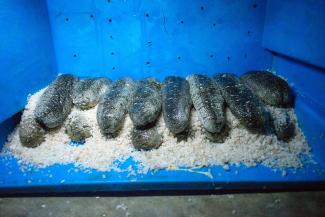Seven Ways USAID is Investing in People and the Planet
“The forest is our market, our hospital, our bank.” — Huitoto Indigenous leader in the Pucaurquillo community, Loreto, a region in the Peruvian Amazon
USAID has been investing in the planet — and all of us who depend on it — for decades. From conserving key species to empowering communities who depend on natural resources, the Agency and its partners are working across the globe to safeguard nature.
This Earth Day, we’re highlighting that work in action with these seven stories
1. Sustainably harvesting marine food sources
As demand for some marine species has increased, their populations have plummeted. USAID projects are bringing sustainable harvesting techniques to fisheries to benefit both humans and other creatures. This blog, “Celebrate an Unlikely Conservation Hero,” describes how USAID and its partners are leading efforts to develop sea cucumber and seaweed fisheries in Madagascar.

Zack Taylor, USAID/Madagascar
2. Conserving key species
Did you know that animals pollinate more than three quarters of major food crops? Without their services, your meals would look very different. USAID activities support the cultivation of healthy environments in which pollinators like insects and birds can thrive. This blog, “Pollinators: A Key Piece of the Development Puzzle,” describes the vital role of pollinators in food security, and USAID’s efforts to protect them.

Eastern tiger swallowtail (Papilio glaucus) drinking nectar from zinnia flower.
Susanna Jolly
3. Tapping into agroforestry to improve community resilience
Some days it seems that chocolate consumption is a requirement for many of us, but the people responsible for producing this chocolate–the farmers–are struggling as they face the pervasive threat of climate change. This blog “How Chocolate Stimulates Taste Buds, Forests, and Communities” describes several of USAID’s activities that support cacao farmers to better manage and restore key landscapes such as forests, grasslands, and peatland.

Emile Gatson, cacao farmer.
Fenohenintsoa Jerry Andrianaivoarivony for USAID/Madagascar
4. Eliminating illegal logging and improving livelihoods
One-quarter of global greenhouse gas emissions come from deforestation and land use. Illegal logging is a major contributor to deforestation — and, in turn, a threat to the lives and livelihoods of communities in the Amazon. A USAID project in Peru is giving Indigenous communities the tools to combat illegal logging and to receive a fair price for those trees they choose to harvest.

Teobaldo Vásquez ready to visit the community of Pucaurquillo in Loreto, Peru.
Liliana Lizárraga, USFS
5. Mobilizing Finance for Nature
Looking for something to listen to on your way home from work? Check out the Green Invest Asia podcast for an inside look at how USAID is partnering with agriculture and forestry businesses in Southeast Asia to adopt low-emissions practices and connect with green investors. Shifting public and private finance toward natural climate solutions is critical given that addressing the climate and biodiversity crises will require investments in nature to triple by 2030 and increase four-fold by 2050 from the current $130 billion spent annually.

USAID Green Invest Asia
USAID
6. Increasing opportunities for women’s leadership on conservation
Traditionally, wildlife officers and community scouts in Zambia have been almost exclusively men. But in order for a whole community to see the benefits of wildlife and conservation, everyone must be allowed and encouraged to participate. This blog “Breaking Down Employment Barriers in Zambia: Increasing Opportunities for Female Community Scouts” describes USAID efforts to expand employment opportunities to women and demonstrates how rural women in these leadership roles can be changemakers for effective natural resource management.

A warden for Lower Zambezi National Park in Zambia who is also a mentor to Zambia’s first all-women community scout patrol unit.
David Nangwenya for USAID ILRG
7. Equipping women to increase their families’ resilience
Women produce as much as 80% of global food supplies, yet they are much less likely to control resources or receive technical training than men. As the Medium blog “Climate Change is not Gender Neutral” explains, a USAID partnership with PepsiCo in India is empowering women farmers with new skills to adapt to the effects of climate change.
On this Earth Day, these are just a few examples of the breadth of USAID’s work investing in the planet to conserve nature and biodiversity, and to increase the resilience of local communities whose wellbeing and livelihoods depend on a sustainable, healthy environment.

USAID is partnering with PepsiCo to empower women farmers in West Bengal, India.
Subarna Maitra, ILRG
About the Author
Christine Chumbler is a biodiversity communications consultant supporting USAID’s Sharing Environment and Energy Knowledge project.

